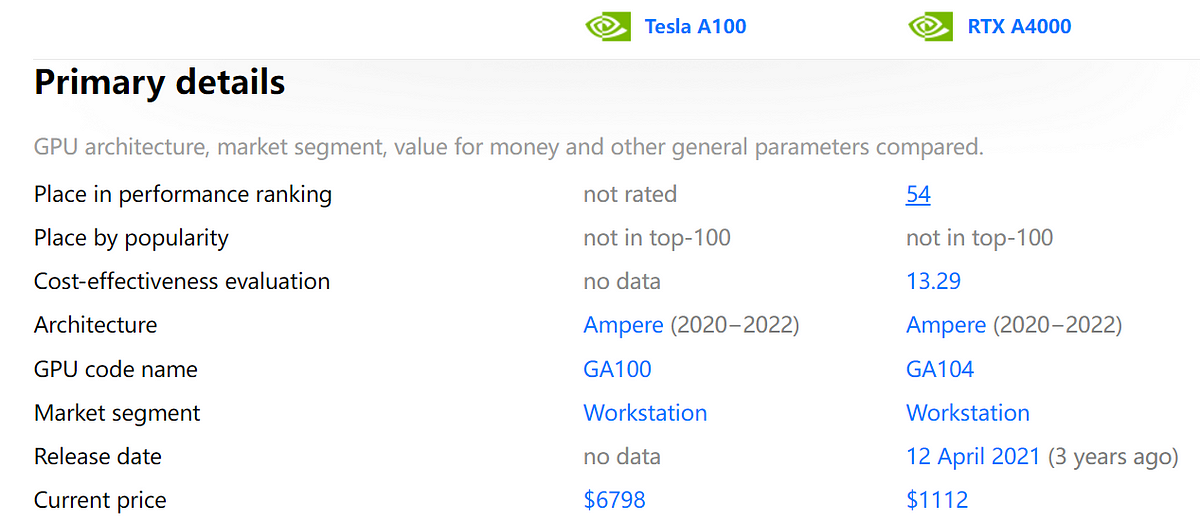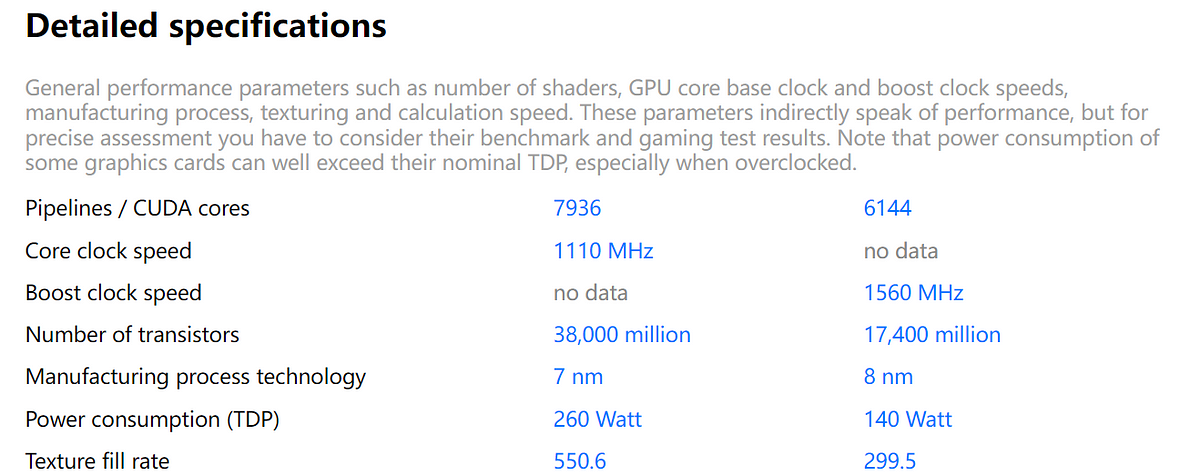NVIDIA RTX A4000 vs A100: Which is Worth It?

Introduction
NVIDIA is a top GPU manufacturer with popular models like the RTX A4000 and A100. The RTX A4000 is ideal for professionals needing high performance for tasks like 3D rendering and video editing, while the A100 targets speed and power for gamers and graphics enthusiasts. This post compares their features, performance, and value to help you choose the right GPU for your needs.
The brief Intro of NVIDIA RTX A4000 and A100
NVIDIA has come up with two mighty graphics cards, the RTX A4000 and the A100. Even though they both carry the NVIDIA RTX name, they’re made for different folks doing different strokes.
The Evolution and Market Position
NVIDIA has been making better GPUs for years. They’re always improving, and the RTX series shows how committed they are to making great graphics cards. The RTX A4000 and A100 are new products. These GPUs have advanced features for professionals and gamers. They’re now some of the best choices for workstation or gaming desktops.

Key Features at a Glance
Let’s dive into what makes the NVIDIA RTX A4000 and A100 stand out:
For the RTX A4000:
- It packs 6144 CUDA cores.
- Comes with a solid 16 GB of GDDR6 VRAM.
- Hits up to a boost clock speed of 1560 MHz.
Moving on to the A100:
- This one steps it up with 6912 CUDA cores.
- Boasts an impressive 80 GB HBM2e for its VRAM capacity.
- Reaches a boost clock speed of about 1410 MHz.

Performance Showdown
When we talk about how well they work, both the NVIDIA RTX A4000 and the A100 do a great job. But because they’re made for different kinds of users, you’ll see some differences in what aspects of performance they focus on.
Computing Power and Speed
The NVIDIA RTX A4000 and A100 stand out because they are fast and powerful. This is important for people who use GPU-accelerated apps for things like machine learning and big data.
The A4000 can handle multiple tasks at once thanks to its 6144 CUDA cores. It works well with popular tools like TensorFlow and PyTorch, which means it can train and run machine learning models efficiently.

The A100 has 6912 CUDA cores. It can handle lots of data and complex calculations. It’s great for people starting AI or deep learning projects. Plus, it has a lot of VRAM, which helps boost performance.
Energy Efficiency and Sustainability
Think about how much energy something uses and if it’s good for our planet. The NVIDIA RTX A4000 and A100 are great examples. They work well and don’t use much power.
The A4000 uses only 140 watts, so it’s perfect for people who want to save energy but still want their computer to run smoothly.
The A100 has more computing power but uses less power than the A4000. NVIDIA’s smart design ensures high-quality graphics don’t use too much electricity.
Detailed Specifications Compared
When comparing the detailed specifications of the NVIDIA RTX A4000 and A100, it’s essential to consider factors such as memory capacity, core architecture, and connectivity.
Let’s take a closer look at how these two graphics cards stack up against each other:

Memory Capacity and Type
When comparing the NVIDIA RTX A4000 vs A100, consider the memory capacity and type. The A4000 has 16GB of GDDR6 memory, great for machine learning, deep learning, and simulations. The A100 has 40GB of HBM2 memory, which is great for AI and large datasets. The A4000 uses GDDR6, while the A100 uses HBM2, which is fast and efficient. The memory capacity and type are important in choosing a GPU for your applications.
Core Architecture Differences
The graphics card’s core architecture affects its performance and capabilities. Let’s look at how the NVIDIA RTX A4000 and A100 are different.
The A4000 has 6144 CUDA cores. This setup is great for workstation tasks because it’s fast and efficient. It also uses the PCIe 4.0 x16 interface to move data quickly and work well with new tech.
The A100 uses the GA100 architecture and has more CUDA cores: 6912. It’s built for high-performance computing. It also uses the PCIe 4.0 x16 interface, which helps it fit into systems that support this technology.
Use Cases and Application Scenarios
The NVIDIA RTX A4000 and the A100 are built for different tasks, each shining in its own area. Here’s a look at what they’re best at:
Best Fit for Professionals and Industries
The NVIDIA RTX A4000 and the A100 are both made for pros and various industries, but they’re different.
The RTX A4000 is a top pick for architects, designers, and engineers. It’s a workstation graphics card that can handle complex tasks and big chunks of data.
The A100 is great for gaming on a desktop. It’s also great for scientific research. It’s great for machine learning experts and those doing deep learning and data analysis.
Gaming, Design, and Scientific Research Performance
NVIDIA’s RTX A4000 and A100 GPUs are great for gaming, graphics, and science.
The A4000 is great for workstations, offering smooth gameplay and realistic visuals with real-time ray tracing.
The A100 is great for gaming and scientific research. It’s fast and has lots of memory for tasks like machine learning and data analysis.
Cost and Price Analysis
Cost and Pricing Structure:
- NVIDIA A4000: Priced at approximately $1,000, ideal for entry-level, professional design, visualization, and edge computing.
- NVIDIA A100: Priced around $10,000, suited for intensive compute tasks like AI training and high-performance computing (HPC).
Price-to-Performance Ratio:
- A4000: Cost-effective for graphics-intensive tasks where top-tier capabilities are unnecessary.
- A100: Beneficial for organizations dealing with deep learning and extensive data analysis, proving valuable despite the higher cost due to its ability to expedite workflows and enhance productivity.
Application Suitability:
- A4000: Adequate for smaller-scale and mid-level visual computing tasks.
- A100: Unmatched in high throughput and computation-needy environments, ideal for simulations, cryptographic processing, and extensive machine learning tasks.
Try Renting GPU Cloud Service to Avoid High Cost
After comparing them, you probably know which one to choose. You might be put off by the price of each GPU. Why not have a brand-new perspective to make use of excellent GPU resource without the high cost upfront? Novita AI GPU Instance offers you this possibility! Novita AI GPU Instance offers a robust a pay-as-you-go platform for developers to harness the capabilities of high-performance GPUs.

By opting for the Novita AI GPU Instance instead of purchasing physical A100 cards, developers can experience a host of advantages that streamline development processes and optimize operational efficiencies. Here are some of the key benefits:
- Dynamic Resource Allocation: With Novita AI, developers can instantly upscale or downscale their A100 resources based on the demands of their projects. This level of flexibility is not possible with physical hardware, which is fixed and might either be underutilized or become a bottleneck.
- Cost-Effectiveness: Investing in physical A100 cards involves significant upfront costs, which can be restrictive, especially for startups and small enterprises. Novita AI’s GPU Instance operates on a pay-as-you-go model, vastly reducing the initial financial burden and turning capital expenditure into operational expenditure.

- Zero Maintenance: Handling physical GPUs entails ongoing maintenance, upgrades and sometimes unforeseen repairs, all of which can disrupt project timelines and budgets. With Novita AI, all hardware management is taken care of by the provider, allowing teams to focus solely on their core development work without worrying about hardware issues.
- Remote Accessibility and Collaboration: Novita AI’s cloud-based instances allow teams to access their GPU resources from anywhere in the world, facilitating easy collaboration and remote working scenarios. This is particularly beneficial in today’s global workforce environment.
Conclusion
The NVIDIA RTX A4000 and A100 are similar, but the choice depends on your needs and budget. The A100 is all about performance, especially for long-term use. If you want to save money but still get quality work, the A4000 is a good choice. Think about what you’ll use it for. This will help you decide which one to get. Each of these GPUs has something special to offer, whether you’re looking for speed and power or a more eco-friendly and affordable option. Think about what matters most to you and how well the GPUs perform in key areas to find the one that’s right for you.
Frequently Asked Questions
Which GPU is better for AI and machine learning tasks?
NVIDIA A100 got better performance and more capabilities than the RTX A4000. Thanks to its strong build, lots of memory, and cool features, the A100 is great at dealing with tricky machine learning algorithms, inference jobs, and deep learning projects.
Can the RTX A4000 handle real-time ray tracing effectively?
Absolutely, the RTX A4000 can manage real-time ray tracing really well. Thanks to its special cores for ray tracing and cutting-edge design, this graphics card offers lifelike lighting, shadows, and reflections as they happen.
How do these GPUs perform in multi-GPU configurations?
The RTX A4000 and A100 are great when you use more than one GPU together. Thanks to their strong designs and cool features, they can really make the most out of having multiple GPUs working at once.
Novita AI is the All-in-one cloud platform that empowers your AI ambitions. Integrated APIs, serverless, GPU Instance — the cost-effective tools you need. Eliminate infrastructure, start free, and make your AI vision a reality.
Recommended Reading: